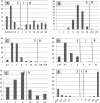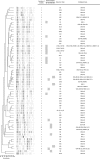Diversity of Carbapenemase-Producing Escherichia coli Isolates in France in 2012-2013
- PMID: 29866863
- PMCID: PMC6105832
- DOI: 10.1128/AAC.00266-18
Diversity of Carbapenemase-Producing Escherichia coli Isolates in France in 2012-2013
Abstract
With the dissemination of carbapenemase-producing Enterobacteriaceae (CPE) strains worldwide, carbapenem-hydrolyzing enzymes are increasingly reported among isolates of Escherichia coli, the first hospital and community-acquired opportunistic pathogen. Here, we have performed an epidemiological survey of carbapenemase-producing E. coli (CP-Ec) isolates received at the French National Reference Centre (F-NRC) in 2012 and 2013. Antimicrobial susceptibilities for last-resort antibiotics and antimicrobial compounds commonly used to treat urinary tract infections were determined by broth microdilution. Clonal relationship was assessed using repetitive sequence-based PCR (rep-PCR) and multilocus sequence typing (MLST). From this collection of 140 carbapenemase-producing E. coli isolates, 74% produced an OXA-48-like carbapenemase and 21% produced an NDM carbapenemase. A link with a foreign country was suspected for 37% of infected/colonized patients. Most of the isolates were from screening (56%) and from urine samples (26%). Colistin, fosfomycin, and nitrofurantoin possessed the most consistent activity, with 100%, 95%, and 96% isolates susceptible, respectively. A wide diversity of carbapenemase-producing E. coli isolates has been found (50 different sequence types [STs]). The most prevalent clones were (i) E. coli sequence type 38 (ST38) producing OXA-48 (n = 21), a clone linked to Turkey and North African countries, (ii) E. coli ST-90 producing OXA-204 (n = 9), which was responsible for an outbreak related to a contaminated duodenoscope, and (iii) E. coli ST-410 producing OXA-181 (n = 5), which was recovered from patients of different geographical origins. These specific clones might be considered high-risk clones for the dissemination of carbapenemases in E. coli The wide diversity of STs, combined with the increasing number of CP-Ec isolates received by the F-NRC, suggests a likely dissemination of CP-Ec isolates in the community.
Keywords: KPC; MLST; NDM; OXA-48; VIM; carbapenemase; epidemiology; molecular epidemiology; rep-PCR.
Copyright © 2018 American Society for Microbiology.
Figures



References
-
- Albiger B, Glasner C, Struelens MJ, Grundmann H, Monnet DL, European Survey of Carbapenemase-Producing Enterobacteriaceae working group . 2015. Carbapenemase-producing Enterobacteriaceae in Europe: assessment by national experts from 38 countries, 2015. Euro Surveill 20 (45):pii=30062 https://www.eurosurveillance.org/content/10.2807/1560-7917.ES.2015.20.45.... - DOI - PubMed
-
- Grundmann H, Glasner C, Albiger B, Aanensen DM, Tomlinson CT, Andrasević AT, Cantón R, Carmeli Y, Friedrich AW, Giske CG, Glupczynski Y, Gniadkowski M, Livermore DM, Nordmann P, Poirel L, Rossolini GM, Seifert H, Vatopoulos A, Walsh T, Woodford N, Monnet DL; European Survey of Carbapenemase-Producing Enterobacteriaceae (EuSCAPE) Working Group. 2017. Occurrence of carbapenemase-producing Klebsiella pneumoniae and Escherichia coli in the European survey of carbapenemase-producing Enterobacteriaceae (EuSCAPE): a prospective, multinational study. Lancet Infect Dis 17:153–163. doi:10.1016/S1473-3099(16)30257-2. - DOI - PubMed
-
- Semin-Pelletier B, Cazet L, Bourigault C, Juvin ME, Boutoille D, Raffi F, Hourmant M, Blancho G, Agard C, Connault J, Corvec S, Caillon J, Batard E, Lepelletier D. 2015. Challenges of controlling a large outbreak of OXA-48 carbapenemase-producing Klebsiella pneumoniae in a French university hospital. J Hosp Infect 89:248–253. doi:10.1016/j.jhin.2014.11.018. - DOI - PubMed
Publication types
MeSH terms
Substances
LinkOut - more resources
Full Text Sources
Other Literature Sources
Medical
Research Materials
Miscellaneous

